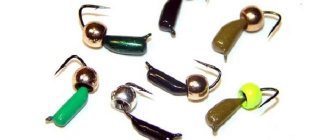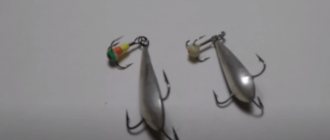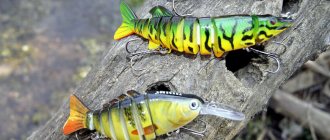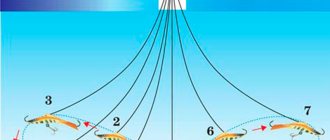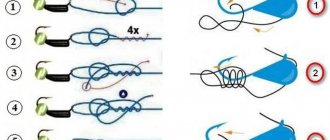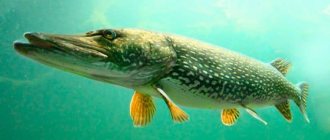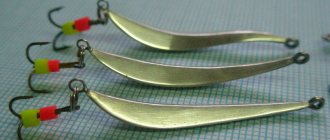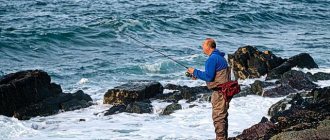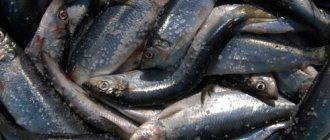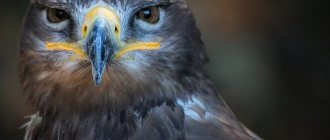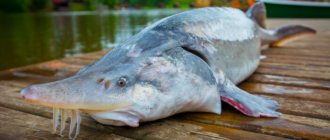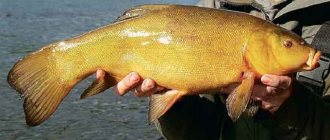“Balda” has been rapidly gaining popularity among fishermen for more than 20 years. Especially often, this original, varied and catchy tackle, which does not require additional bait and can be completely made in warm home conditions, is used for winter fishing. Abroad, such tackle is called a vertical jig.
Varieties
We have many varieties of equipment purchased or assembled with our own hands for fishing. They will differ in cargo:
- weight;
- form;
- blossom.
Depending on this, different hooks can be used; usually they choose the same length as the load or a little shorter.
Depending on the color of the sinker, you can catch different fish:
- catching bream on a bulldozer will be successful if the load is colored red and white;
- darker colors attract predators, in particular, perch fishing is carried out using tackle with a black sinker;
- golden and silver bodies are considered universal, and it is this that pike perch often reacts to.
In some cases, faceted bodies are used, so the shine will attract even more fish, but can also scare them away with the same success.
Victoria Leshchenko
I've been working hard in the fishing tackle department for the past six years. I can help you assemble almost any gear.
Ask a Question
There is a microbalda, its sinker is small but quite heavy, most often made of tungsten.
From the shore
If you are fishing from the shore, then choose a short rod, as you will have to constantly play with the bait. In this case, the rigidity of the rod is necessary. The coil is inertia-free. From the shore, this bait is used to catch fish that are standing in holes.
Look at the video on how to equip a fishing rod for fishing:
Perch fishing
Most of all, perch like this bait. Fishing for perch in open water on Baldu begins immediately after spawning. It is better to catch perch with a long, 5-6 meter rod; the final length will depend on the width of the river. To reduce the length of the rod, some fishermen enter the water dressed appropriately in rubber overalls. The balda is tied on a side nod, which must be rigid. On the rod, the tulip changes to a nod. If you leave the tip, then there will be a large percentage of unrealized bites with it. A soft tip will not be able to hold the fish, there will be a lot of catches. The perch rod itself has a considerable weight. Weighty baits attract perch very well with their tapping action.
For perch fishing
The playing technique for this fish is as follows: after tapping 2-3 times on the bottom, you need to raise the bulldozer 30 centimeters from the bottom, then lower it a little, lift it again, lower it again, and so on 4-5 times. Thus, the bulldozer will rise one and a half meters from the bottom level. Then comes the descent. Rising and falling, the bully spreads its legs, giving the perch the impression that a bug is swimming. Where one perch bites, others will come. Don't leave the area after the first bite, try again.
You can use a bait without a bait to catch fish, or you can add a maggot or a worm. In the video you can see how perch is caught:
Grayling fishing
Grayling loves to be on river rifts, reaches, but not the rapids themselves. It is on fast rivers that you can catch grayling on a bullhead. The gear consists of a rod, an inertial reel, with a large supply of fishing line, about 100 meters, a float and the rod itself.
Here the bulldozer is a float, about 10 centimeters long. Some fishermen fish with an even larger float, 15 to 30 centimeters long. The weight of the float may fluctuate depending on the current and depth of the site. In shallow water, with a calm current, floats weighing up to 15 grams are used, in rapid waters, heavy ones, up to 100 grams. This float is made of wood and a lead weight is attached to it. The weight should be designed so that the float is half immersed in water. You can make a foam plastic float or arrange the production of such floats from propylene window seals; they already have the shape of a tube. Two or three leashes with artificial flies or live flies are attached to the fishing line. These flies lie on the water. The leashes are made of thinner fishing line. This type of gear has other names, but I will call it what our grandfathers called it.
Grayling
When fishing for grayling, leashes and fishing line should not lie on the water. You also need to make sure that they do not twist among themselves. It often happens that grayling sits on 2 hooks at once. You need to cast the bait so that it splashes less on the water. Grayling is a shy fish, so you need to take the necessary precautions.
Watch the video of making the gear:
How to fish with bullfish
The technique of fishing with a bulldozer is not difficult, but this is only at first glance. Only in skillful hands will the tackle play as it should and be able to attract the attention of a worthy trophy. The existing nuances will divide fishing with gear into two types, each of which will be slightly different.
Fishing in winter
Most often they use balda for catching perch in winter, but other types of fish can also respond to the tackle. It’s easier to fish from the ice, a hole is drilled in the place of direct accumulation and bites often occur during the first descent, the fish rushes to the bulldozer when it has not yet reached the bottom.
But this does not always happen; sometimes you need to experiment and choose the most successful type of game specifically for this body of water and the place on it. It is worth understanding that the fish takes the artificial bait when moving, if bites occur when placing live bait on the hooks, then the balda is not attractive as bait in this body of water.
Victoria Leshchenko
I've been working hard in the fishing tackle department for the past six years. I can help you assemble almost any gear.
Ask a Question
You need to use the boom skillfully; if pulling up and down are not effective, then you can try shaking the bait or find your own method of attracting the attention of the fish.
Fishing with bullfish in summer
In the summer, you can fish for balda both from the shore and from a boat. In this case, completely different rod blanks are used, which can definitely show the bite.
Catching from the shore is carried out with 4-meter fishing rods with the obligatory use of a side nod. Many people think that with its help they watch for a bite, but this is an incorrect judgment; a nod serves as an indicator of the game. It is by its vibrations that you can see how the bait plays and what movements it performs at this time.
Fishing from a boat is carried out with side rods, short-length rods that allow you to tap the bottom in the immediate vicinity of the watercraft. This method is often used to catch pike perch on a boat from a boat, and in most cases with a successful outcome.
It is with the help of a boom that you can fish snags on a river or lake and not lose your gear, so very often fishing with a boom is more effective than a spinning rod.
Grayling fishing on a bulldozer is carried out only in open water; for this purpose, spinning rods are used for long-distance casting, and the tackle itself is slightly modified. The sinker is tied separately at the very end of the tackle, and the flies are on a leash in front of it; a float will show the bite.
It is also effective to use just before the freeze-up, in November, when the float gear has not been working for a long time. Tapping coastal holes in most cases gives a good result, the fisherman returns home with his catch.
Fishing on the Baldu - some subtleties and techniques
In appearance, the “balda” is a weight attached to the tip of the fishing line, to which a pair of hooks are loosely attached along with beads on the fore-end. The bait is placed on the bottom, knocked on it, then thrown up low and released down. All movements should be made smooth and sweeping, the nod of the tackle should seem to describe ovals. Thus, the bait moves unevenly through the water, unevenly - a real “bullshit”!
"Balda" is a bait for highly active fish. Quite successful results are achieved with its use in the first couple of weeks after the formation of ice on reservoirs. At this time, the fish are more hungry than ever and are very aggressive, so the appearance of our bait, its dimensions and color mean quite little. In deep winter it is worth carefully selecting the color of the beads in order to force the predator to somehow fall for the bait. However, fish can be active not only during the first ice season. On the Volga, for example, fishing is excellent with “balda” even in the middle of winter (January, February), that is, in the real dead and cold season of the year. The main thing is to find active fish, and in a large and flowing body of water you can find them almost constantly. It is possible to catch large perch in reservoirs using a “balda” throughout the entire winter season. Only with the exception of certain periods in which the perches are in a certain state of apathy, but the “striped” ones are excellently caught in this way. In moments of absolute lack of bite in the dead of winter, a large perch ceases to be interested in throwing itself at spinners, but besides, due to its sizeable dimensions, it does not look at all at other small jigs. It turns out to be a vicious circle: the spinner turns out to be too large and sharp for him, and the jig is completely inconspicuous. It is tedious to select something of medium size.
The bait should be moved smoothly and sweepingly; the bait prefers freedom. They lower it to the bottom of the reservoir, then knock on it as if with a hammer, and gradually draw oval “curls” on the surface with a nod. And you know approximately how exactly the bait will behave in the water column. Falling to the bottom, it provokes clouds of turbidity and at the same time intensively waves its “legs” - the beads turn all the movements of the hooks into smooth and very natural steps.
“Balda” has proven itself optimally on sandy and muddy bottoms, but is poorly effective on rocky terrain. As can be seen from experience, there is no need to throw the “balda” high from the bottom, this once again alerts the prey. This type of bait is typically bottom bait, suitable for spot fishing. The most important movement of the bait is the waving of the “legs”, that is, the hooks. It is at this moment that the fish prefers to grab the “balda”. During the lifting process, the hooks are compressed with the body, and when lowered slightly, the “legs” rise up. Tapping on the bottom and lifting with oval movements is the main technique for working with the “balda”.
Features of winter fishing
It is impossible to determine who invented the design for winter fishing. It is believed that it was invented by the people. Nevertheless, the bulldozer is a winter tackle that is quite effective.
Fishing for perch in winter has its own specifics. To make it, use:
- sinker,
- fishing line,
- hooks
The latter is necessary in order to make bait. It has an eye through which the fishing line is threaded. Hooks, in turn, are attached to it. Beads are fixed on them, which attracts fish.
The tackle must be kept in an upright position at all times. What are the specifics of fishing:
- First lower the bulldozer to the bottom of the reservoir.
- Tap the bait several times and lift it slightly. The perch swallows the bait on the hook.
In winter, fish are not as active as in summer. This is why it is necessary to practice smooth movements. Anglers sometimes believe that the more colorful the bead on the bait looks, the better the bite. You can use a microbalda to catch perch in winter and autumn.
Fishermen have been waiting for fishing in winter on Baldu since summer. As soon as the reservoir is covered with ice, they go hunting, holding this bait in their hands. It is better to find an area 2 meters from the coast in early December. It is necessary to choose days when the weather is sunny and the wind blows from the south.
During the dead of winter, predatory fish split into several groups and move into deep holes. Here the water contains a large amount of oxygen. During this period, she reduces activity. You will have to spend a lot of time to find its habitat. As soon as the ice melts, the predator resumes its activity, and there is every chance of catching large specimens.
To stir up the perch, they use a balda for winter fishing. Often the success of fishing depends on it. Winter gear necessarily includes such elements as:
- multi-colored cambric,
- drop-shaped weight,
- hooks, including various elements,
- hard fishing rod.
As for the fishing line, you need to take 0.2 mm products. Anglers use rattles when using a spinner. To add them to the tackle, drill slots at the bottom of the bait and place small balls from the bearings there. After this, the surface is sealed.
Fishing for perch in winter using water is convenient. Fishing him out doesn't cause any problems. What are the secrets of the equipment? When it sinks to the bottom, clouds of turbidity form in the water. When the bulldozer hits the bottom, the predator feels it and is attracted to it.
The more turbidity, the more effective the fishing. A hungry fish, seeing a cloud of turbidity, rushes at everything, without thinking about the potential danger. Cambrics should be taken in the following colors:
- green,
- yellow,
- red.
The weight of the load in still waters should not be more than 10 g. If fishing is carried out on a river, the weight of the bait should be 25 g.
DIY making
To make a perch catcher with your own hands, you need to be patient. Difficulties can arise not only for beginners, but also for experienced fishermen. The set of materials includes several long hooks and lead weights, which are shaped like a bullet or drops. You will also need 0.2 mm fishing line. How to mount a winter canopy:
- attach hooks, sinkers and beads to the fishing line,
- slightly separates the distance from the weight, make a knot from fishing line,
- from the resulting loop, hooks and weights are able to move freely and are equipped with a cambric,
- prepare a clay mold. Fill it with molten lead
- as soon as the metal hardens, remove the mold with a drill and make holes on top of a weight with a diameter of 2 mm,
- chamfer the hole made and use a large drill. This is required to prevent chafing of the fishing line.
We can consider the production of the bulldozer completed. The next stage is painting the bait. It is usually black or red. If you are not going to mount the boom on the perch yourself, you can buy it at the store.
Some fishermen have their secrets. They use a perch boom with a runner. This can lead to the most frequent bites. To do this, the bait is supplemented with another hook. Secure it to the fishing line. When the game with the fish begins, the slider slides along a piece of fishing line. In this way, the predator can be provoked to attack.
Perch search tactics
The tactics of searching for a striped predator when fishing with a “balda” are not much different from fishing with other gear. For some, it will be a revelation that the “bulda” is a tackle that catches in almost any conditions. If there are no bites in a certain place for a long time, then, as a rule, there are no fish in this location. The key to success is to actively search for a predator, regardless of the type of water area.
If fishing takes place in winter, the most promising areas for this time of year are fished first:
- along the first ice - at the border of aquatic vegetation, in flooded shallow waters with the presence of bushes, driftwood and snags, on the upper edges and areas with anomalies of the bottom relief. At the beginning of winter, the predator continues to “graze” near its favorite summer locations;
- in the low season - below the edges, in places of exit from holes and dumps, in areas with a sandy and rocky bottom, places with a good oxygen regime;
- end of winter, beginning of spring – shallow areas near the border with aquatic vegetation.
The search for perch sites on the river begins with exploring attractive areas along the coastline: driftwood and snags sticking out of the water, steep banks and slopes, trees that have fallen into the water.
In the summer, perch is caught in a plumb line using a boat. The presence of a vessel makes it easier to find schools of perch and makes it possible to carry out classic bait fishing. After all, as mentioned earlier, this tackle involves active and dynamic play, which is only possible when fishing with winter fishing rods.
The concentration of the predator and its activity in summer largely depend on the time of day and weather conditions. Perch is not a heat-loving fish species, so it is most active when the water warms up to a temperature of 20-22℃. If the temperature of the aquatic environment surrounding it becomes higher, its activity decreases. At this time, he tries to go to deeper places rich in oxygen.
Searching for the striped robber in the heat is a tedious task and most often futile. An exception to the general rule is fishing in the morning and evening hours. It is at this time that the predator’s peak activity occurs, when it goes to the shallows to feed. At night, the perch does not bite at all and its capture at this time is purely an accident.
In summer, a good guide to finding schools of perch is a concentration of seagulls hunting for small fish. If you notice such a concentration of “feasting” birds, be sure that a perch is also staying nearby.
Typical habitats for perch in summer are flooded trees and boulders, objects casting shadows, the border of aquatic vegetation, windows between thickets of water lily leaves.
Spoon-bait
Once, while fishing, I had the idea to apply the principle of “bullshit” in vertical lures. Often, a spoon is able to attract the attention of a perch, but no attack occurs. The reasons may be different: the general passivity of the fish, the “not hungry” season, and some flaws in the bait’s performance. In such cases, what is called a “bomb” is needed, that is, an unexpected move or an attractive detail. In this case, two hooks above the spoon played this role. The hooks are not fixed; they move freely along the loop to which the spoon is attached. I saw the result on my first fishing trip: there were much fewer empty hooks, and a considerable part of the caught perches were caught on the top hooks.
The game of the bait is very specific. When swinging, the hooks are pressed against the spoon, when gliding they go up, and during a pause, when the spoon settles after the swing, the hooks smoothly return down. Usually at this moment perch pokes occur. It is very useful to tap this spoon on the bottom. Then the hooks begin to move, like those of a “balda”. During periods when the perch is passive, such tapping turns out to be very effective. You need to knock with the lower end of the spoon, where the tee is located, and in no case should the upper half of the bait be lowered to the bottom, otherwise the hooks will not work as they should. When tapping, the hooks move up and down synchronously, and bites occur during pauses, when the spoon stays in place a little longer. The bites are rarely sharp.
Despite the fact that the main bait is a spoon, fish most often attack the top hooks. Perhaps this is due to the fact that the spoon is too large for them, or the basic natural instinct is triggered - to take it away. The equipment imitates a fish (spoon) that has grabbed something tasty (hooks with beads) and is trying to eat it. And the perch wants to take away the “tidbit” from its competitor.
A perch may reject a bait for a variety of reasons, including not liking the color of the beads. I once talked about this topic with one experienced “no-attacher”. According to his observations, Volga perch likes only three colors: white, red and black. And he uses only such cambrics on baitless jigs. Yielding to his influence, I put beads of the same color on the hooks, and so that they would not fly off the hooks, I fixed them with cambric.
On one fishing trip, I decided to try fishing with such a “bully” spoon all day long. I fished with my friend, also a spinner. He was using simple single-hook perch spoons that day without any bells and whistles. Things have been going well for me since the morning. In the first hole I caught three good perches one after another, two of which were caught on the top hooks. There were bites in almost all the holes, but many of them did not end in anything. Nevertheless, from each hole I got from one to five perches, but my friend was bored until lunch, although we were fishing in the same place. As a result, by the end of the day my box was 4 kg heavier, but my friend, until he tied the same hooks above the spoon, caught only two perches. But then I quickly caught a dozen “humpback whales” using the top hooks. Of my 20 bass, 17 were caught on top hooks. The bites were not sharp, the perch attacked the bait during pauses, after I hit the bottom with the bait several times. Several strikes were from bottom to top, when the perch apparently struck from below, lifting the nod upward. Fishing, I must admit, was laborious, but that’s why it was interesting.
